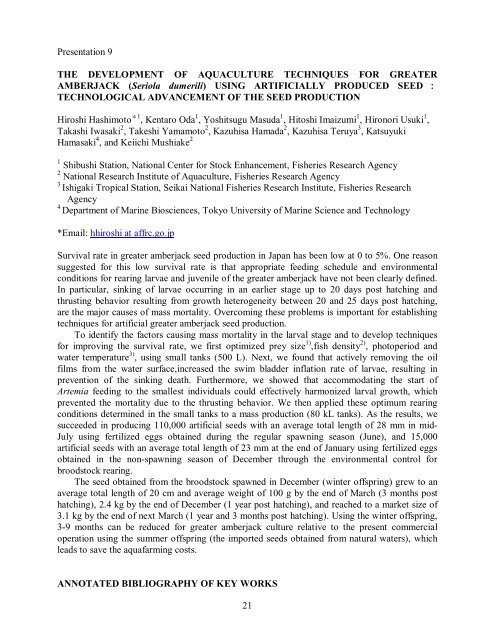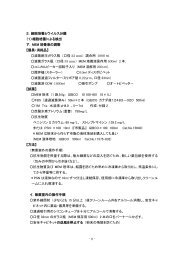Program and Abstracts(PDF)
Program and Abstracts(PDF)
Program and Abstracts(PDF)
You also want an ePaper? Increase the reach of your titles
YUMPU automatically turns print PDFs into web optimized ePapers that Google loves.
Presentation 9<br />
THE DEVELOPMENT OF AQUACULTURE TECHNIQUES FOR GREATER<br />
AMBERJACK (Seriola dumerili) USING ARTIFICIALLY PRODUCED SEED :<br />
TECHNOLOGICAL ADVANCEMENT OF THE SEED PRODUCTION<br />
Hiroshi Hashimoto *1 , Kentaro Oda 1 , Yoshitsugu Masuda 1 , Hitoshi Imaizumi 1 , Hironori Usuki 1 ,<br />
Takashi Iwasaki 2 , Takeshi Yamamoto 2 , Kazuhisa Hamada 2 , Kazuhisa Teruya 3 , Katsuyuki<br />
Hamasaki 4 , <strong>and</strong> Keiichi Mushiake 2<br />
1 Shibushi Station, National Center for Stock Enhancement, Fisheries Research Agency<br />
2 National Research Institute of Aquaculture, Fisheries Research Agency<br />
3<br />
Ishigaki Tropical Station, Seikai National Fisheries Research Institute, Fisheries Research<br />
Agency<br />
4<br />
Department of Marine Biosciences, Tokyo University of Marine Science <strong>and</strong> Technology<br />
*Email: hhiroshi at affrc.go.jp<br />
Survival rate in greater amberjack seed production in Japan has been low at 0 to 5%. One reason<br />
suggested for this low survival rate is that appropriate feeding schedule <strong>and</strong> environmental<br />
conditions for rearing larvae <strong>and</strong> juvenile of the greater amberjack have not been clearly defined.<br />
In particular, sinking of larvae occurring in an earlier stage up to 20 days post hatching <strong>and</strong><br />
thrusting behavior resulting from growth heterogeneity between 20 <strong>and</strong> 25 days post hatching,<br />
are the major causes of mass mortality. Overcoming these problems is important for establishing<br />
techniques for artificial greater amberjack seed production.<br />
To identify the factors causing mass mortality in the larval stage <strong>and</strong> to develop techniques<br />
for improving the survival rate, we first optimized prey size 1) ,fish density 2) , photoperiod <strong>and</strong><br />
water temperature 3) , using small tanks (500 L). Next, we found that actively removing the oil<br />
films from the water surface,increased the swim bladder inflation rate of larvae, resulting in<br />
prevention of the sinking death. Furthermore, we showed that accommodating the start of<br />
Artemia feeding to the smallest individuals could effectively harmonized larval growth, which<br />
prevented the mortality due to the thrusting behavior. We then applied these optimum rearing<br />
conditions determined in the small tanks to a mass production (80 kL tanks). As the results, we<br />
succeeded in producing 110,000 artificial seeds with an average total length of 28 mm in mid-<br />
July using fertilized eggs obtained during the regular spawning season (June), <strong>and</strong> 15,000<br />
artificial seeds with an average total length of 23 mm at the end of January using fertilized eggs<br />
obtained in the non-spawning season of December through the environmental control for<br />
broodstock rearing.<br />
The seed obtained from the broodstock spawned in December (winter offspring) grew to an<br />
average total length of 20 cm <strong>and</strong> average weight of 100 g by the end of March (3 months post<br />
hatching), 2.4 kg by the end of December (1 year post hatching), <strong>and</strong> reached to a market size of<br />
3.1 kg by the end of next March (1 year <strong>and</strong> 3 months post hatching). Using the winter offspring,<br />
3-9 months can be reduced for greater amberjack culture relative to the present commercial<br />
operation using the summer offspring (the imported seeds obtained from natural waters), which<br />
leads to save the aquafarming costs.<br />
ANNOTATED BIBLIOGRAPHY OF KEY WORKS<br />
21



